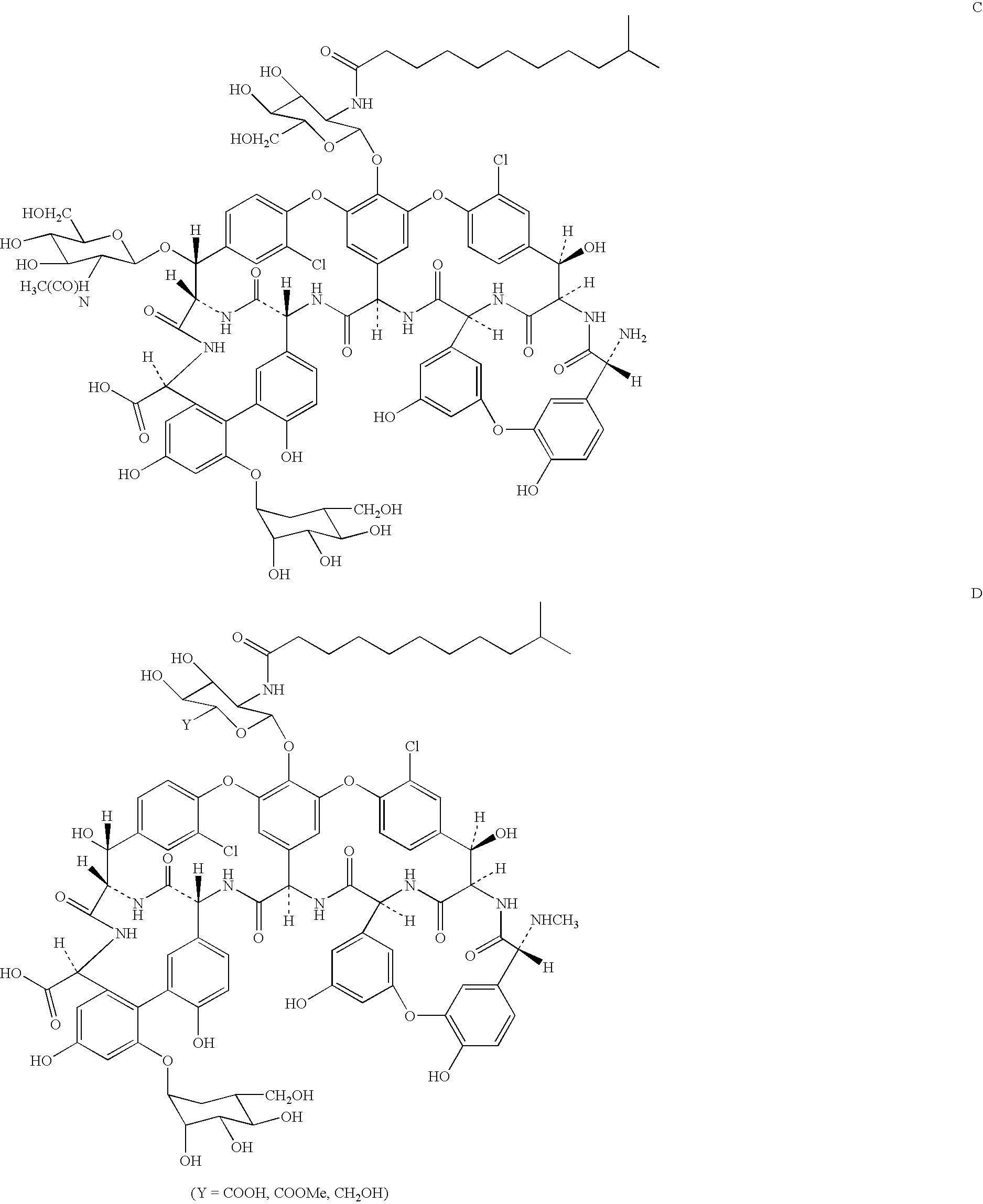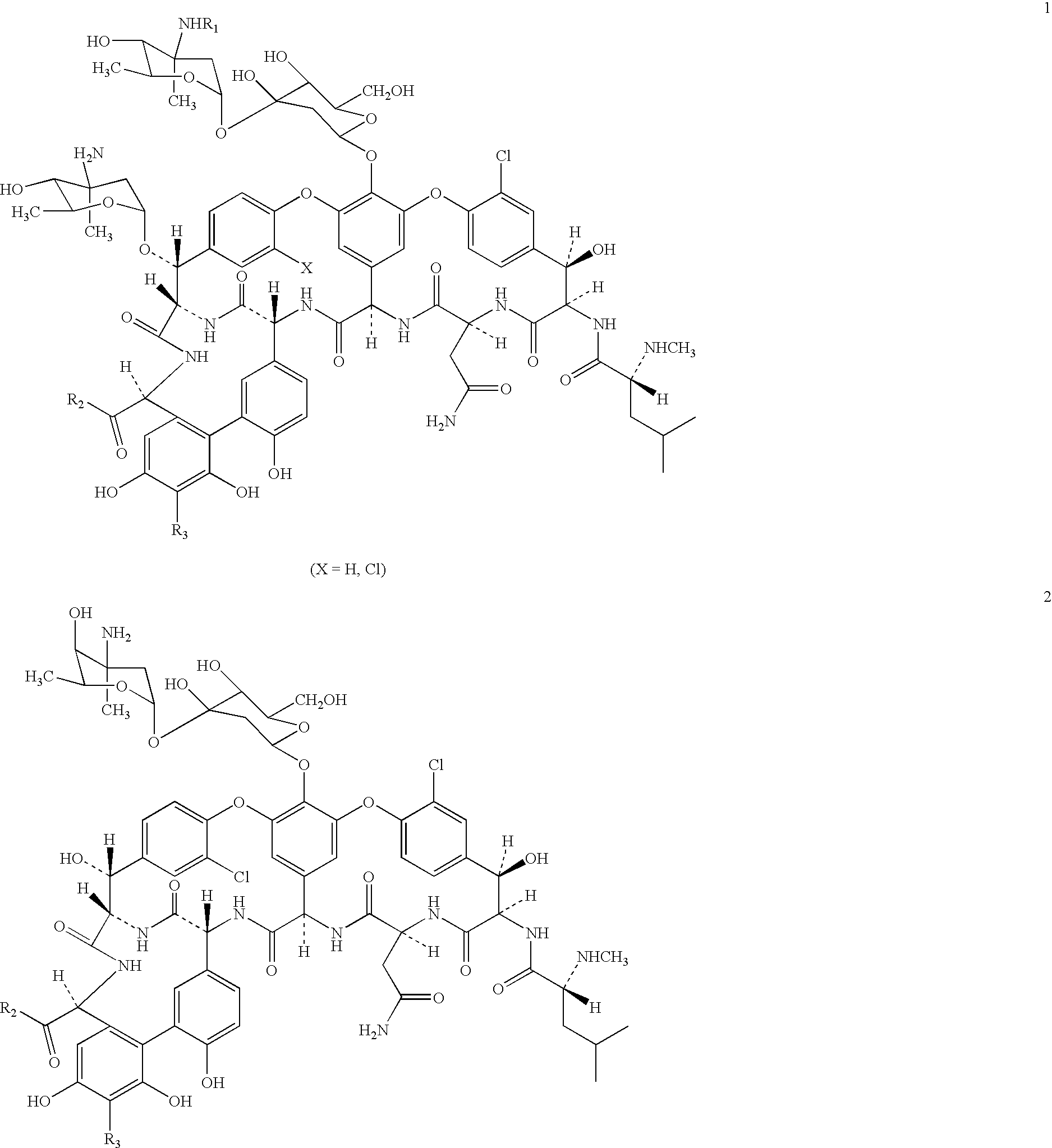Semi-synthetic glycopeptides with antibiotic activity
a technology of synthetic glycopeptides and antibacterial activity, which is applied in the direction of antibacterial agents, peptides/protein ingredients, peptides, etc., can solve the problem of limited
- Summary
- Abstract
- Description
- Claims
- Application Information
AI Technical Summary
Benefits of technology
Problems solved by technology
Method used
Image
Examples
example 1
Synthesis of N′-Alkylaminoacylated Eremomycin and Vancomycin Derivatives
[0201]N′-Alkylaminoacylated eremomycin or vancomycin derivatives were prepared by the treatment of unprotected eremomycin or vancomycin with RCH2N(Fmoc)CH2COOSu (where R=p-BuPh, p-CIPhPh, p-BuOPh and p-octylOPh) followed by deprotection with 10% diethylamine in DMSO. Eremomycin derivatives were obtained in 30-50% summary yields. Vancomycin derivatives were obtained in 30-60% summary yields. The starting glycine derivatives were synthesized as shown and described below in Scheme 1 and the associated description of steps I, II and III.
[0202]
I. Reductive Alkylation of Glycine (Synthesis of RCH2NHCH2COOH).
[0203]To a stirred solution of glycine (2 mmol) in THF:H2O mixture (1:1) at room temperature a solution of 1 mmol of an appropriate aldehyde in THF and 1.5 mmol of NaCNBH3 were added portion-wise. The reaction mixture was stirred for 4 h, then water was added. The resulting mixture was evaporated under vacuum to re...
example 2
Preparation of N′-[C8H17OC6H4CH2NHCH(CH3)CO] Vancomycin
[0209]
CmpdRchemical formulaMW301p-C8H170BnNHCH(CH3)COC84H102N10O26Cl21736.6
[0210]
I. Reductive Alkylation of L-alanine (Synthesis of p-C8H17OC6H4CH2NHCH(CH3)COOH)
[0211]To a stirred solution of L-alanine (1 mmol) in THF-H2O mixture (1:1) at 26-28° C. a solution of 1 Mmol of p-C8H17OC6H4CHO in THF and 0.75 mmol of NaCNBH3 were added portion-wise. The reaction mixture was stirred at 26-28° C. for 4 h, then water was added. The resulting mixture was evaporated under vacuum to remove THF and to precipitate the product of the reaction. The precipitate was filtered off and washed with icy cold water. The solid was dissolved in THF-H2O mixture (1:1) and this mixture was kept at 5° C. for 18 h. A white solid (L-alanine) was filtered off and washed with icy cold water, the filtrate was evaporated under vacuum to remove THF and to precipitate the product of the reaction. The precipitate was washed with acetone and dried under vacuum. The yi...
example 3
Synthesis of N′-Aminoacyl (Non-Glycyl) Derivatives of Eremomycin
[0215]N′-Acylated eremomycin derivatives substituted with amino acids or N-alkylated amino acids and a vancomycin derivative were prepared by the treatment of an antibiotic with N-hydroxysuccinimide ester of N-Fmoc-derivatives of amino acids or N-alkylated amino acids, followed by deprotection with 10% diethylamine in DMSO gave a desirable product in 10-50% summary yields. The starting derivatives of amino acids were synthesized as shown and described below with reference to Scheme 3.
[0216]
Preparation of N-Hydroxysuccinimide Ester of Nα,Nε-di-Fmoc-L-Lys (Scheme 3a)
[0217]N-Hydroxysuccinimide ester of Nα,Nε-di-Fmoc-L-Lys was obtained from Nα,Nε-di-Fmoc-L-Lys by the method C (see below).
Preparation of N-hydroxysuccinimide Ester of N-Fmoc-L-Phe and N-Fmoc-D-Phe (scheme 3b).
[0218]N-Hydroxysuccinimide ester of N-Fmoc-L-Phe was obtained by the method C from N-Fmoc-L-Phe, prepared from L-Phe by the method B.
Preparation of N-Hyd...
PUM
| Property | Measurement | Unit |
|---|---|---|
| volume | aaaaa | aaaaa |
| volume | aaaaa | aaaaa |
| volume | aaaaa | aaaaa |
Abstract
Description
Claims
Application Information
 Login to View More
Login to View More - R&D
- Intellectual Property
- Life Sciences
- Materials
- Tech Scout
- Unparalleled Data Quality
- Higher Quality Content
- 60% Fewer Hallucinations
Browse by: Latest US Patents, China's latest patents, Technical Efficacy Thesaurus, Application Domain, Technology Topic, Popular Technical Reports.
© 2025 PatSnap. All rights reserved.Legal|Privacy policy|Modern Slavery Act Transparency Statement|Sitemap|About US| Contact US: help@patsnap.com



